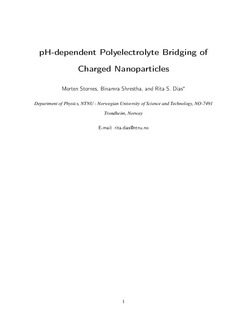| dc.contributor.author | Stornes, Morten | |
| dc.contributor.author | Shrestha, Binamra | |
| dc.contributor.author | Dias, Rita de Sousa | |
| dc.date.accessioned | 2019-01-17T11:39:40Z | |
| dc.date.available | 2019-01-17T11:39:40Z | |
| dc.date.created | 2018-10-12T16:37:11Z | |
| dc.date.issued | 2018 | |
| dc.identifier.citation | Journal of Physical Chemistry B. 2018, 122 (44), 10237-10246. | nb_NO |
| dc.identifier.issn | 1520-6106 | |
| dc.identifier.uri | http://hdl.handle.net/11250/2581051 | |
| dc.description.abstract | Systems comprised of polyelectrolytes and charged nanoparticles are of great technological interest, being common components in formulations among other uses. The colloidal stability of formulations is an important issue, and thus a lot of effort has been made to study the interactions of individual components in these systems. Here, the complexation and adsorption of an annealed (pH-dependent) polyelectrolyte to two spherical nanoparticles has been studied using coarse-grained Monte Carlo simulations. This has been done mainly by varying the solution pH and separation distance (concentration) between the nanoparticles. The polyelectrolyte charge distribution is seen to vary with nanoparticle separation distance, and its ability to bridge both nanoparticles changes with pH. The flexible polyelectrolyte creates compact, multilink bridges at short nanoparticle separation distances and evolves to a stretched single-link bridge at longer distances, where a larger fraction of the polyelectrolyte wraps around the nanoparticles. The annealed polyelectrolyte is also compared with a quenched polyelectrolyte of similar fixed fractional charge. Here, a difference is found in the adsorption ability at low pH/ionization due to the ability of the annealed polyelectrolytes to concentrate charges in the vicinity of the nanoparticle. At intermediate polyelectrolyte charge fractions and with increasing nanoparticle separation distances, the annealed system is able to link nanoparticles at larger distances as compared to the quenched, in good agreement with experimental observations. The results in this work contribute to the understanding of the effect of annealed polyelectrolytes and pH variations in the phase behavior of polyelectrolyte–nanoparticle systems, potentially aiding in the design and optimization of pH-responsive systems. | nb_NO |
| dc.language.iso | eng | nb_NO |
| dc.publisher | American Chemical Society | nb_NO |
| dc.title | pH-Dependent Polyelectrolyte Bridging of Charged Nanoparticles | nb_NO |
| dc.type | Journal article | nb_NO |
| dc.type | Peer reviewed | nb_NO |
| dc.description.version | acceptedVersion | nb_NO |
| dc.source.pagenumber | 10237-10246 | nb_NO |
| dc.source.volume | 122 | nb_NO |
| dc.source.journal | Journal of Physical Chemistry B | nb_NO |
| dc.source.issue | 44 | nb_NO |
| dc.identifier.doi | 10.1021/acs.jpcb.8b06971 | |
| dc.identifier.cristin | 1620095 | |
| dc.description.localcode | © American Chemical Society 2018. This is the authors accepted and refereed manuscript to the article. Locked until 11.10.2019 due to copyright restrictions. | nb_NO |
| cristin.unitcode | 194,66,20,0 | |
| cristin.unitname | Institutt for fysikk | |
| cristin.ispublished | false | |
| cristin.fulltext | postprint | |
| cristin.qualitycode | 2 | |

